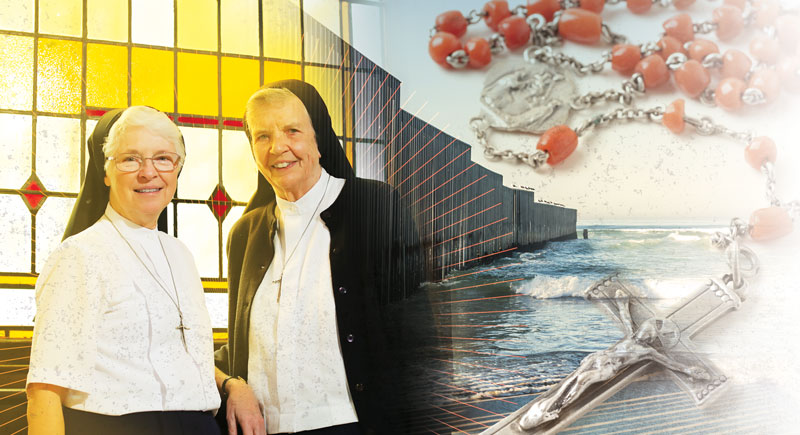Michael Stevens used to get a discounted bike every year as a perk of racing with a team, but he can’t buy one at all now without paying top dollar and waiting months on end. Bike shops are largely empty, he says, with backlogs going well into next year. Tires and other components are harder to find and more expensive, and repairs must be scheduled well in advance.
COVID-19 prompted many people to cancel their gym memberships and invest in biking instead, leading to double-digit growth for bicycle shops. “Some industries are struggling, and others are booming,” Stevens says. “It’s just a total change in whose pockets are getting filled.”
After 30 successful years as a supply chain management professional, Stevens joined Immaculata’s business faculty last year, using his expertise to create a new Bachelor of Science in supply chain management. Drawing on his global experience in demand planning and supply optimization, he is teaching students to contend with the imbalances in supply and demand that caused not just a bike shortage but worldwide disruptions in the production and delivery of goods and services.
Uncertainty and volatility
“Since supply chains are so interconnected, it’s like dominoes. They all affect each other,” Stevens says. “If you have one bottleneck, it’s going to go all the way downstream.” The pandemic created spikes in demand for many items—face masks, computer chips, cars, groceries, home exercise equipment and much more. Without enough lead time to adapt, companies are struggling to keep pace. Factory shutdowns, worker shortages, employment and productivity impacts of vaccination and mask mandates and economic recovery across different countries have complicated the equation.
Apart from the pandemic, many other dynamics also affect the supply chain. Stevens mentions fluctuations in currencies and exchange rates, political unrest, trade regulations and market changes, to name a few. “All of this is going to create volatility,” he says. “If we had perfect information, and everybody collaborated, and customers told us exactly what they wanted, because they knew, and we had enough time to plan for it, we’d have no inventory”—that is, supply would match demand perfectly. The more data and market intelligence you have, the better you can forecast demand to minimize both excess inventory and out-of-stock items.
Supply chain managers: the quarterbacks of their companies
Supply chain managers are like quarterbacks, Stevens says. They help to synchronize a company’s activities amid the chaos with a systematic plan, often by facilitating a four-step sales and operations planning process. First, they confer with the company’s marketing and sales teams to determine what customers want and define the demand. Second, supply chain managers meet with the operations and purchasing teams to determine supply constraints. Third, a cross-functional group discusses ways to match supply with demand in a way that both satisfies customers and generates profit. And fourth, when business objectives conflict, executives make tradeoffs, deciding which to optimize. In these tough situations, Stevens says, supply chain managers can give executives the facts and facilitate making informed business decisions.
“I think that supply chain management is one of the most fascinating careers to have, because it’s so multifaceted, and because it interfaces with every function in the business process,” Stevens reflects. “It’s really all about understanding your total customer needs and wants, and then working collaboratively to find the most effective and efficient and profitable way to satisfy those needs and wants.”
Stevens outlines eight steps in the global supply chain. “Any step can become a bottleneck and create uncertainty,” Stevens says. For example, raw materials or components may fail inspection. A supplier may go out of business, causing companies to scramble for alternatives. Multiple industries may compete for limited supplies, driving prices up and causing shortages. A lack of truck drivers can delay transportation, clogging major ports with goods that can’t be delivered, as the U.S. has recently experienced.
A Basic Supply Chain for a Bicycle
- Planning: Design a bike that will satisfy customers and make a profit.
- Information: Gather the latest data on demand trends, supply considerations and production to decide how many bikes to make and the necessary resources.
- Sourcing: Find suppliers who provide good materials for a good price.
- Inventory: Acquire and maintain the stock of raw materials and components needed to manufacture bicycles.
- Production: Assemble components into bikes, test the finished product, and paint, label and package them.
- Location: Choose manufacturing and storage facilities near raw materials, manufacturer and customers.
- Transportation: Find shipping services to deliver bicycles to retailers quickly for a reasonable cost.
- Return: Establish a process for returning defective bikes and addressing customer complaints.
Prepare for unexpected shifts
Although supply chains have plenty of potential for disruption, Stevens says technology can help mitigate problems, allowing companies to communicate with their customers’ customers and their suppliers’ suppliers. Sharing information helps businesses better anticipate customers’ needs and develop more accurate forecasts for both demand and supply.
Stevens is teaching students how to manage the flow of goods and information through each step in the global supply chain, preparing them to handle the kind of inevitable shifts he experienced with his struggle to find a new racing bike. He speculates that some of the shift away from gyms may be temporary, while part of the shift may become permanent as people change their lifestyles and more of them exercise outdoors.
Stevens’ own lifestyle shifted during COVID. He decided to leave the corporate world and give back to the community through teaching at Immaculata. “That’s where my passion and my interest are right now,” he said. “I love it; this is a great university, it’s a great spirit here.”






